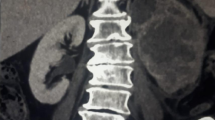Abstract
Chyle is a milky lymphatic fluid that is normally formed in the small intestine to aid in the absorption of dietary fats. Occasionally, chyle leaks into the kidney, ureter, or bladder, which results in chyluria. Chyluria is most commonly caused by the parasite Wuchereria bancrofti and is therefore extremely rare in the USA. The use of robotic surgery for treatment has been suggested as a viable option, but has not been thoroughly reported in the literature. This article reviews the literature on the various treatment options for chyluria and presents the case of a 75-year-old Indian female from the USA who was diagnosed with non-parasitic, persistent chyluria and treated with right robotic ureterolysis, renal hilar dissection and intraperitonealization of the ureter.



Similar content being viewed by others
References
Diamond E, Schapira HE (1985) Chyluria—a review of the literature. Urology 26(5):427–431
Mehta VK, Lohar H, Banerjee GK, Reddy MV, Harinath BC (1999) Surgical filariasis: immunoscreening for filarial IgG antibodies using Wuchereria bancrofti microfilarial excretory-secretory antigen. J Commun Dis 31(1):35–40
Zhang X, Ye ZQ, Chen Z, Chen ZQ, Zhu QG, Xin M, Li LC (2003) Comparison of open surgery versus retroperitoneoscopic approach to chyluria. J Urol 169(3):991–993
Sachit S, AshokKumar H (2009) Chyluria-an overview. Nephro Urol Mon 1(1, Summer):14–26
Parthasarathy S, Miller FH, Casalino DD (2012) Chyluria. J Urol 187(5):1856–1857
Nishiyama Y, Yamamoto Y, Mori Y, Satoh K, Takashima H, Ohkawa M, Tanabe M (1998) Usefulness of technetium-99m human serum albumin lymphoscintigraphy in chyluria. Clin Nucl Med 23(7):429–431
Ciferri F, Glovsky MM (1985) Chronic chyluria: a clinical study of 3 patients. J Urol 133(4):631–634
Panchal VJ, Chen R, Ghahremani GG (2012) Non-tropical chyluria: CT diagnosis. Abdom Imaging 37(3):494–500
Zagoria RJ, Childs DD (2012) Update on thermal ablation of renal cell carcinoma: oncologic control, technique comparison, renal function preservation, and new modalities. Curr Urol Rep 13(1):63–69
Cortvriend J, Van Nuffel J, Van den Bosch H, Van Erps P (1998) Non-parasitic chyluria: a case report and review of the literature. Acta Urol Belg 66(3):11–15
Zhuo W, Chai J, Xu T, Wu W, Yang S, Tan J (2013) Retroperitoneoscopic single-site renal pedicle lymphatic disconnection for the treatment of serious filarial chyluria. Can J Urol 20(2):6726–6729
Brunkwall J, Simonsen O, Bergqvist D, Jonsson K, Bergentz SE (1990) Chyluria treated with renal autotransplantation: a case report. J Urol 143(4):793–796
Panicker KN, Arunachalam N, Kumar NP, Prathibha J, Sabesan S (1996) Efficacy of diethylcarbamazine-medicated salt for microfilaraemia of Brugia malayi. Natl Med J India 10(6):275–276
Zhang XU, Zhu QG, Ma X, Zheng T, Li HZ, Zhang J, Pan TJ (2005) Renal pedicle lymphatic disconnection for chyluria via retroperitoneoscopy and open surgery: report of 53 cases with followup. J Urol 174(5):1828–1831
Köckerling F (2014) Robotic vs. standard laparoscopic technique—what is better? Front Surg 1:15. doi:10.3389/fsurg.2014.00015
Salman M, Bell T, Martin J, Bhuva K, Grim R, Ahuja V (2013) Use, cost, complications, and mortality of robotic versus nonrobotic general surgery procedures based on a nationwide database. Am Surg 79(6):553–560
Menon M, Hemal AK (2004) Vattikuti Institute prostatectomy: a technique of robotic radical prostatectomy: experience in more than 1000 cases. J Endourol 18(7):611–619
Hoznek A, Hubert J, Antiphon P, Gettman MT, Hemal AK, Abbou CC (2004) Robotic renal surgery. Urol Clin N Am 31(4):731–736
Peschel R, Neururer R, Bartsch G, Gettman MT (2004) Robotic pyeloplasty: technique and results. Urol Clin N Am 31(4):737–741
Menon M, Hemal AK, Tewari A, Shrivastava A, Shoma AM, El-Tabey NA, Ghoneim MA (2003) Nerve sparing robot assisted radical cystoprostatectomy and urinary diversion. BJU Int 92(3):232–236
Sodergren MH, Darzi A (2013) Robotic cancer surgery. Br J Surg 100(1):3–4
Aggarwal R, Darzi A, Yang GZ (2010) Robotics in surgery—past, present and future. Med Sci 2
Lavery HJ, Small AC, Samadi DB, Palese MA (2011) Transition from laparoscopic to robotic partial nephrectomy: the learning curve for an experienced laparoscopic surgeon. JSLS J Soc Laparoendosc Surg 15(3):291
Sinha RK, Ranjan N, Singh N, Amit K (2015) Chyluria: a scourge of our region. BMJ Case Rep 2015:bcr2014209188
Author information
Authors and Affiliations
Corresponding author
Ethics declarations
Conflict of interest
Naman Barman and Michael Palese declare that they have no conflict of interest.
Human and animal rights
All procedures performed in studies involving human participants were in accordance with the ethical standards of the institutional and/or national research committee and with the 1964 Helsinki Declaration and its later amendments or comparable ethical standards. This article does not contain any studies with animals performed by any of the authors.
Informed consent
Informed consent was obtained from all individual participants included in the study.
Rights and permissions
About this article
Cite this article
Barman, N., Palese, M. Robotic surgery for treatment of chyluria. J Robotic Surg 10, 1–4 (2016). https://doi.org/10.1007/s11701-016-0560-5
Received:
Accepted:
Published:
Issue Date:
DOI: https://doi.org/10.1007/s11701-016-0560-5




